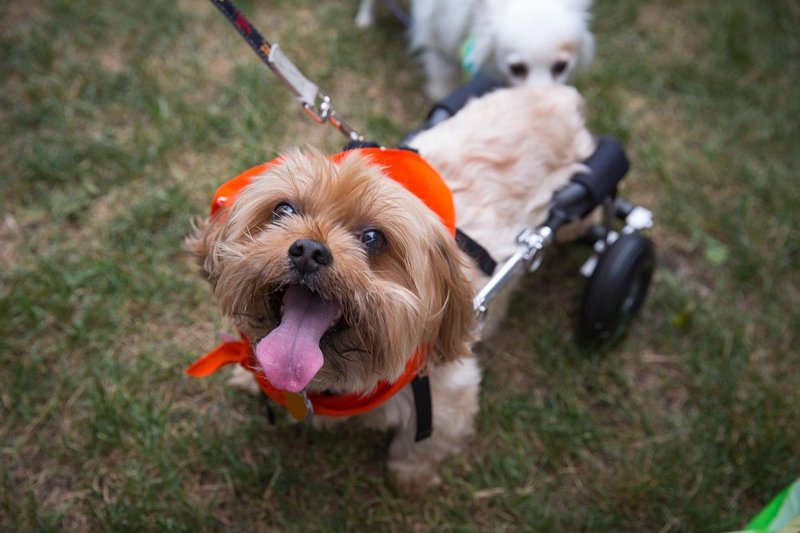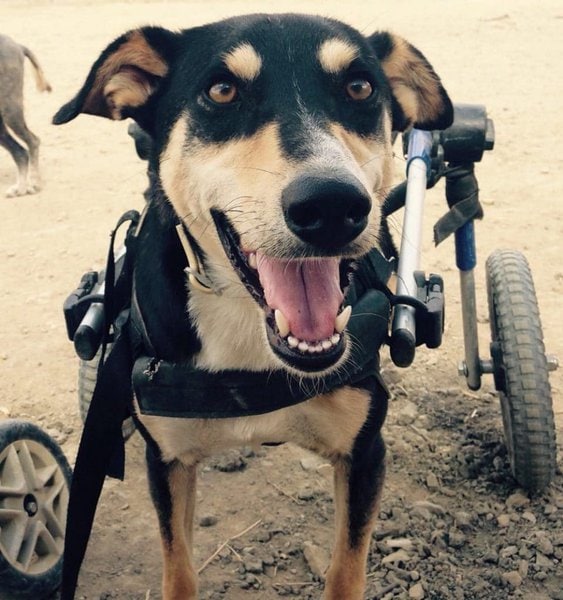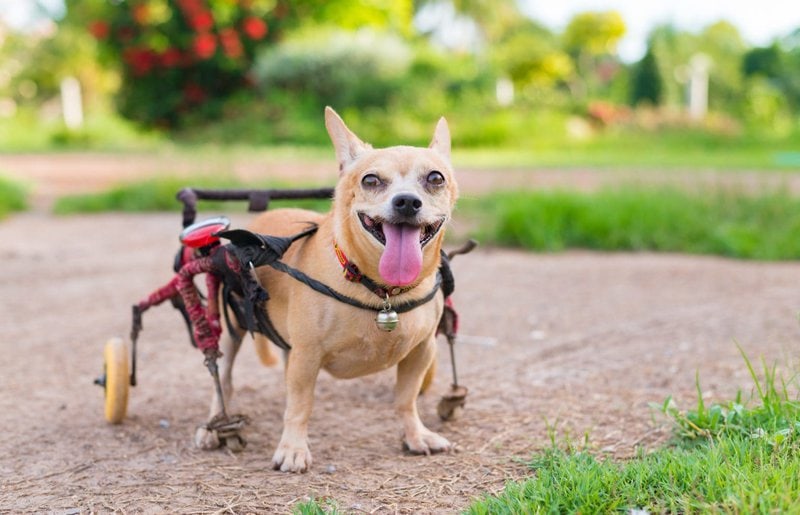The best dog wheelchair is Walkin’ Wheels Dog Wheelchair.
Dogs with mobility issues are often overlooked, but that doesn’t mean they don’t need the same love and care as all other dogs. A dog wheelchair can be a lifesaver for certain breeds who have trouble getting around due to injury or age.
These medical mobility devices are used for dogs who can no longer use their back legs or suffer from debilitating joint pain as a result of physical injuries and health conditions such as arthritis, dysplasia, and paralysis.
In a dog wheelchair, it grants your dog the mobility to lead an improved quality of life. Dog owners typically buy wheelchairs for their dogs after they’ve been recommended by vets or specialists in veterinary medicine.
Dog wheelchairs come in many different styles, including harnesses, carts, slings, etc. In this article, we take an in-depth look at how to choose the best dog wheelchair.
#1 Walkin’ Wheels Dog Wheelchair
Walkin’ Wheel Dog Wheelchair for a large dog is our top pick, and it’s ideal for dogs with rear legs disabilities. As the name suggests, the wheelchair is suitable for larger dog breeds such as Doberman and German Shepherd, the very same breed the 46th POTUS has. It’s also perfect for older dogs weighing between 70 to 180 lbs and growing between 17 to 20 inches in length.
These wheelchairs from Walkin’ Wheels are made of light aluminum frames, which are light enough for easy mobility. They are also weatherproof and extremely durable.
These wheelchairs are also easy to use. They come with safety belts tied to the dog’s belly and hind legs for better support. The straps can be adjusted in width and length for comfort. Their wheels are strong enough to avoid puncturing. They allow the dog to walk on both smooth and rough surfaces. They make the perfect dog wheelchairs for a rear leg disability.
Walkin’ Wheels Dog Wheelchairs are made to be tough yet comfortable. They are strong yet light, and they come with a soft harness that makes them more comfortable for your pooch. While using this dog wheelchair, your canine friend can maneuver perfectly on both rough and smooth surfaces. It’s our top choice for a dog wheelchair that delivers value for money.
Pros
- The patented adjustable design of the Walkin’ Wheels wheelchair makes it possible for customers to modify the height, length, and width of the product to conform to a pooch’s size requirements and specific health needs.
- This canine wheelchair product features dense foam wheels, with rubber treads, that don’t puncture easily and make it easier for a pooch to travel over different land terrains.
- The durable and lightweight structure of this wheelchair product is sturdy enough to provide the required support for pooches with weak back legs to move about freely.
- All the parts of this canine wheelchair – including the foam/rubber wheels – are washable, hence making maintenance of the product easier for owners.
- Customers can collapse and fold the Walkin’ Wheels wheelchair product flat, thereby making it convenient to store the product where there is minimal storage space.
Cons
- Some dogs have reportedly found it difficult to balance and use the wheels of this canine wheelchair product.
- Several customers have bemoaned the poor customer service rendered by this canine wheelchair brand.
We choose this product as the top pick because it can be folded and flattened to fit into the comparment of any type of motor vehicle with ease and its versatile design can conform to the varying sizes of medium to large dog breeds.
#2 K9 Carts The Original Dog Wheelchair
Our budget-conscious pick is The Original Dog Wheelchair from K9 Carts. This is a handmade cart for smaller dogs weighing between 5 to 45 lbs. These dog wheelchairs cater to dogs with rear legs inability or limited function.
They are made of a top-grade aluminum rod that is commonly used in building aircraft, making them the lightest wheelchair on the market. They can be adjusted both in length and height. These dog wheelchairs’ harnesses have pads that help to prevent pressure sores while holding up by supporting the pelvis to avoid more injury.
The wheelchair is comfortable and doesn’t restrict the dog when using the bathroom. Its wheels are well-balanced for better stability. It’s a highly recommended affordable wheelchair for dogs with rear legs immobility and with strong forelegs.
This veterinary-approved wheelchair has been in use for over 50 years without disappointment. It comes with intact leg pads and fits any small dog properly. If you are looking for a dog wheelchair that gives value for money, then the K9 Carts is your best option.
Pros
- This canine wheelchair product comes with straps that can be adjusted to provide a convenient and comfortable fit for a pooch while ensuring that the wheelchair doesn’t come off.
- The use of aircraft-grade aluminum material to construct this canine wheelchair product ensures that the chair can be used by a pooch for a considerable period before a replacement is needed.
- K9 Carts’ wheelchair product is available in various size options – Extra-Small, Small, Small-Medium, Medium, and Large – to ensure compatibility with different dog sizes.
- The K9 Carts dog wheelchair is fabricated and assembled in the United States to ensure that stringent manfacturing standards have been met.
- The cable leg rings of this canine wheelchair are covered with contoured, dense foam padding to prevent the development of pressure sores and provide additional pelvic support for pooches.
Cons
- Several customers have reportedly received a poorly fit K9 Carts wheelchair, despite providing the manufacturers with their pooch’s exact measurements.
- This product isn’t suitable for use with dogs that are front amputees.
#3 Best Friend Mobility Large Dog Wheelchair
When looking for a wheelchair suitable for large dogs with rear legs disability, the Best Friend Mobility Large Dog Wheelchair is a great option. These wheelchairs have the ability to stabilize and provide good support to your disabled dog. They are made from light aluminum which ensures easy effortless movement.
These dog wheelchairs are fitted with a superb neoprene rear strap and padded shoulder pads for total comfort. They also have uniquely designed legs and come in attractive colors.
With the Best Friend Mobility Large Dog Wheelchair, the injured dog is certain to enjoy its daily adventures without limitation of movement. These dog wheelchairs are stable and comfortable for your dogs.
Pros
- The Best Friend mobility wheelchair features deluxe front and rear harnesses that ensure that the product is comfortable to wear for a pooch.
- Customers can conveniently adjust the height and length of this large dog wheelchair, to conform to their pooch’s specific needs, with a hex wrench.
- The Best Friend is formulated for, and effective at providing support to pooches suffering from medical conditions such as hip dysplasia, arthritis, degenerative myelopathy, and any other condition that typically results in rear leg weakness.
- The Best Friend wheelchair features a lightweight aluminum construction that is convenient for customers to transport from one place to another.
- This canine wheelchair product comes with all-terrain pneumatic wheels and waterproof Swiss bearings to ensure that pooches can enjoy a smooth and steady ride on different terrains.
Cons
- Several customers have reported that they received Best Friend packages with missing parts that made it difficult for them to assemble the wheelchair.
- The wheelchair is reportedly usually unstable after installation, thereby making it unusable for dogs.
#4 SYLPHID Adjustable Dog Wheelchair
If you are looking for a dog wheelchair that’s unique and can cater to dogs with both front and back legs weakness, the SYLPHID Adjustable Dog Wheelchair is the right choice. These dog wheelchairs have both back and front support for a dog with mobility problems.
It has a soft harness and the rods can be adjusted in length and width. The lightweight aluminum frame ensures that the dog is balanced and can move without difficulty. The back and front harnesses are made of neoprene that is comfortable for the dog.
This adjustable dog wheelchair from SYLPHID is highly recommended for small and medium dogs. They are comfortable and help the dog to move even when the front legs are weak or injured.
Pros
- Customers can utilize the tools included in this SYLPHID package to adjust the wheelchair to heights and lengths that can be convenient for their pooches to use.
- The wheels of this canine wheelchair product are spaced wide enough so that they don’t get in the way and interfere with a dog’s movement.
- SYLPHID’s adjustable wheelchair comes in parts that are typically easy for customers to assemble and put together.
- The lightweight design of the SYLPHID wheelchair makes it convenient and easy for pooches to carry and drag the wheelchair behind them.
- The neoprene material used to make this wheelchair’s front and back harnesses is comfortable and gentle on a pooch’s skin.
Cons
- Some customers have reportedly found it difficult to comprehend the instructions that came with this SYLPHID product, thereby making it difficult for them to assemble the wheelchair.
- Multiple customers have reported that this canine wheelchair product did nothing to improve their pooch’s stability.
#5 HobeyHove Adjustable Dog Wheelchair
The HobeyHove adjustable dog wheelchair is something specially designed for injured dogs, with a focus on the hind legs. When worn, it gives handicapped dogs a second chance in life to play, run, and move about. The wheelchair is adjustable and can fit your pet accordingly. You can easily disassemble the wheelchair as well as fold it up for travel or storage.
It has a buckle design that can hang a tow rope and this helps your pet from getting lost. It is made of light and strong material. On the other hand, the strap material is safe for pets due to its soft nature. Remember, you should check out the size chart before purchase, and also remember it works for dogs with hind leg injuries.
We love that you don’t need to keep removing the HobeyHove adjustable dog wheelchair because if the dog needs to go to the bathroom, the wheelchair doesn’t get in the way. The fact that you can fold and store it makes it a winner. The soft straps, buckle design, and lightweight nature of the wheelchair are perfect for your injured or aging pet.
Pros
- Customers can adjust the height, length, and width of the HobeyHove wheelchair to adapt it to their pooch’s specific needs.
- The foldable design of the HobeyHove wheelchair makes it possible for customers to collapse and store the wheelchair when it isn’t in use.
- The soft and breathable abdominal band of this wheelchair product helps to relieve stress and pressure on the pooch’s body and spine when it is running.
- The separate design of the HobeyHove wheelchair ensures that pooches can poop and pee whenever they want, even while wearing the wheelchair.
- The HobeyHove adjustable wheelchair product comes with modular components such as a chest strap, separate socket design, and leg guard ring, all of which can be easily assembled to set up the wheelchair.
Cons
- The wheels of this canine wheelchair product tend to go in reverse whenever a pooch stands up, thereby resulting in the dog falling over.
- The adjustment straps for the front and rear harnesses are considerably thin and usually not very effective for holding the wheelchair in place.
#6 CAMCCE Pet Wheelchair
The CAMCCE pet wheelchair helps your pet to move around if its hind legs are injured. The lightweight aluminum alloy design is comfortable for your dog and should last longer since it will not be affected by dust or corrosion. The wheels are also wear-resistant for enhanced durability.
The wheelchair from CAMCCE has soft and adjustable wrap harnesses that will keep your pet comfortable. It has a belly band for extra spine protection. For extra security, the package comes with a dog leash.
The wheelchair is also easy to install, thanks to the hexagonal wrenches and screw fittings. It works very well for dogs with a slipped disc, arthritis, spinal and neurological conditions.
The CAMCCE Pet Wheelchair offers a lot of support with its soft harnesses and a belly band for spine support. It is light in weight and is made of durable material. It is perfect for injured or sick dogs and is adjustable to fit any dog size.
Pros
- CAMCCE’s pet wheelchair features a belly band that helps to protect and take the pressure off a pooch’s spine.
- The aluminum alloy material used to manufacture this wheelchair product is rustproof and can resist rust damage from exposure to moisture.
- The wear-resistant wheels of the CAMCCE wheelchair can be used to travel over rough terrains without easily getting damaged.
- The soft and adjustable wrap harnesses that come with the CAMCCE wheelchair provide sufficient support for pooches with mobility issues.
- The design of this pet wheelchair product makes it possible for pooches to defecate and urinate without having to take off the wheelchair.
Cons
- This canine wheelchair product comes with so many components that may be difficult for customers without technical know-how to put together.
- The instructions that come with this pet wheelchair product don’t do much to assist customers with the assembly of the wheelchair.
#7 HeoBam Dog Wheelchair
The HeoBam dog wheelchair is designed for your dog if they have an injury to its hind legs. It is also great for pets with spinal, neurological, or bone deformity issues.
This wheelchair from HeoBam comes in six sizes to suit any dog size. It is made of lightweight aluminum alloy, which withstands rust, dust, and wear. The wheelchair joints are detachable, which increases the ease of cleaning and storage.
It has soft and friendly harnesses which will keep your pet comfortable. Its design allows you to attach a wristband or headset as you take a walk with your pet HeoBam wheelchair is easily adjustable without having to disassemble it.
We love that the HeoBam dog wheelchair comes in 6 sizes to suit dogs of any size. It is also lightweight and easy to install. WE also love the soft adjustable harnesses that will keep your dog comfortable.
Pros
- HeoBam’s dog wheelchair product is manufactured with lightweight aluminum material that is resistant to wear and rust, while also being easy for customers to carry.
- The joints of this canine wheelchair product can be detached for storage and the wheelchairs headsets and wristbands can also be buckled together for convenient and quick installation.
- Customers can adjust the height, length and width of this wheelchair product to conform to their pooch’s body shape, without needing to dismantle the wheelchair.
- This canine wheelchair product from HeoBam is equipped with a D-ring that customers can conveniently attach leashes to lead and direct their pooches on walks.
- The adjustable hoop of the HeoBam dog wheelchair can be used to hang a pooch’s back legs for additional support.
Cons
- The straps of this canine wheelchair are considerably stiff and tend to be displaced easily, resulting in customers having to readjust them frequently.
- The HeoBam wheelchair doesn’t come with comprehensive instructions on how to fit the product on a pooch’s body.
Dog Wheelchair Buyer’s Guide
A dog wheelchair is a mobility device that can be used by your four-legged friend to help them get around. Dog wheelchairs are specifically designed for use with dogs of all shapes and sizes, and most models are adjustable to fit any size dog. The design includes a harness that secures the animal in place while they’re being pushed along.
There are many reasons why an owner may want to consider purchasing a dog wheelchair. Whether it’s due to old age, arthritis, or injury, there are plenty of ways that your four-legged friend can benefit from the use of one. The most common reason people choose to purchase a wheelchair for their pet is that they have suffered some type of injury and need help getting around.
The best way to express your love and care for your physically disabled dog is by getting them a wheelchair or cart. The wheelchair or dog cart is basically a device that assists a physically disabled dog with support for walking, running, playing, exercising, and everything it needs to lead an active independent life.
It helps to improve your dog’s quality of life and can even extend the dog’s active life by several years.
Related: Best Dog Joint Supplements
Why And When Your Dog May Need A Wheelchair?
A dog wheelchair is something you may need to consider when your dog struggles with walking, going up and down the stairs, or defecating normally. It’s, however, important to consult your vet first when you notice any mobility problem in your dog. The wheelchair should only be used when the condition that caused the paralysis or mobility issues is untreatable.
There are many causes of mobility problems in dogs, including joint and muscle pain and soreness, weak limbs, physical injuries due to accidents, recovery from surgery, paralysis, spinal problems, amputations, and other neurological problems.
Mobility limitation and hence the need for a dog wheelchair can be a result of the following health conditions:
Degenerative Myelopathy (DM) Disease
Degenerative Myelopathy is a condition that affects older dogs between the ages of 8 and 14 years. The condition is caused by a loss of connectivity between the dog’s brain and spinal cord. There’s still no cure for DM, which is why a wheelchair is an appropriate option, mainly because the dog doesn’t experience any pain. The wheelchair will improve your dog’s mobility and quality of life.
Related: Best Orthopedic Dog Beds
Intervertebral Disc Disease (IVDD)
IVDD is caused by the deterioration or displacement of the cushion between the dog’s spinal discs. It’s a painful condition that affects all types and breeds of dogs, although some are more prone to the disease than others. In severe cases of IVDD, the dog develops weakness or even paralysis of the legs. In such cases, a dog wheelchair is the best recovery option.
Your dog can still maintain the use of its four legs if the condition is discovered at an early stage. A wheelchair helps in the rehabilitation and treatment of IVDD. If the damage is too severe and your dog becomes paralyzed, then the wheelchair will be the only option for your dog.

Dog Arthritis And Dysplasia
Dog arthritis or dysplasia is a condition that causes joint stiffness in dogs. Both arthritis and dysplasia make it difficult for the dog to rely on its hind legs for support. The conditions make the performance of basic tasks such as walking and running extremely painful and almost impossible. Both conditions can be cured or managed by feeding your dog supplements, such as glucosamine, essential fatty acids, and chondroitin sulfate, among others. However, when movement becomes too painful for your dog due to sore joints, then a dog’s wheelchair will be your best option.
Dog Paralysis
Paralysis in dogs can happen due to old age, sickness, or genetic predispositions. There are other complications that can cause sudden or gradual paralysis to your dogs, such as spinal column complications, bacterial infection, and infectious tick bites. Most of these sudden paralysis conditions are treatable when identified and addressed at an early stage. However, you may need a wheelchair to help your dog get by in life, even if the paralysis is only temporary. The wheel will help the dog regain lost mobility while the condition is being treated.
Knee Ligaments And ACL Injuries
If, in the unfortunate event, your dog tears its knee ligaments or ACL, recovery can take a long time. ACL and knee injuries can happen without notice and severely impair your dog’s mobility. There are even cases where the damage can only be corrected by surgery. In such cases, your dog will be required to take a rest until it recovers. It will take a long time before the dog can perform strenuous hikes and runs again. Its physical activities will be severely limited during this recovery period.
The dog will also need sufficient support during this period to ensure that it doesn’t strain and tear adjacent tissues and ligaments. A wheelchair will provide the necessary support and mobility while ensuring that the dog doesn’t overcompensate for the damaged leg.
A wheelchair provides the necessary support and mobility for a dog with an injury or symptoms of the conditions and illnesses discussed above. However, we recommend that you consult a vet or licensed professional to decide on the best option for your dog before going for a wheelchair. Remember, the goal is to give your dog the best possible care and support possible.

Factors To Consider When Looking For The Best Dog Wheelchair
Here are some of the key things to consider when shopping for the perfect wheelchair for a dog with mobility problems:
Size And Weight Of Your Dog’s Limbs
Dog wheelchairs come in different sizes to suit different types of dogs. It’s therefore important to ensure that the wheelchair you choose can accommodate the weight of your dog as well as the length of the dog’s limbs and the height of its shoulders and hips. Check the weight of the wheelchair properly to avoid breakage problems. If you can’t put an adult on a child’s bike, then don’t try to buy your German shepherd a wheelchair meant for a pooch.
Measure your pet correctly to get a wheelchair with the right size and weight for your dog. The measurements should include hip and shoulder height and width and the length of its legs, its full weight, and overall body length. Measure the dog in a standing position. Take accurate measurements, preferably twice, to avoid disappointing mishaps. Make sure the wheelchair can comfortably hold the entire mass of your dog.
The Wheelchair’s Construction Materials
The materials used in the design and construction of the dog wheelchair will have a direct effect on its comfort, strength, performance, and durability. You definitely want a wheelchair that your dog can drag along with ease to find one made of lightweight, preferably aluminum, material. The dog cart should also be strong enough to withstand heavy use and outdoor elements such as rain, mud, sun, and dirt.
Durability is important in a dog’s wheelchair too. Test the wheelchair and see how it can withstand your pet’s usage. You may not know how long your dog will be in the wheelchair, so find a model that will serve the dog for as long as possible.
Cost And Quality
There’s no way you can put a monetary price on the love, care, and concern for your dog. You definitely want the best for your sick dog, but it will be essential to start by checking your budget to determine what type of wheelchair you can afford. Fortunately, there are many options out there with different price points to suit your budget.
Keep in mind that, like everything else in life, you get what you pay for. However, a more expensive model will probably have a few extra features and functions that your dog may never need, while a cheaper option will still be safe and comfortable. Your goal, therefore, is to find a balance between cost and quality. Look for a wheelchair that your dog will enjoy using rather than try to save a few dollars and end up with an uncomfortable cart. A high-quality model will last longer and keep your pet safe and comfortable at all times.
Related: Best Dog Diapers
Final Thoughts
Suppose, for some unavoidable reason, your dog ends up with mobility problems and is probably rendered motionless. In that case, your best course of action is to get the dog a good comfortable and lightweight wheelchair. An adequately designed wheelchair will help your dog walk, play, and lead a happy life.
There are many types and models of dog wheelchairs on the market today, but you’ll never go wrong with our top pick. This is a wheelchair for large dogs that are prone to mobility-limiting conditions such as arthritis and dysplasia. The wheelchair is made of a strong, lightweight, and durable aluminum frame.





